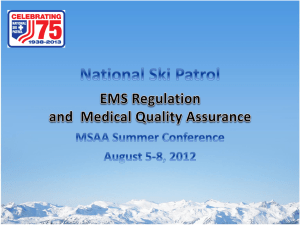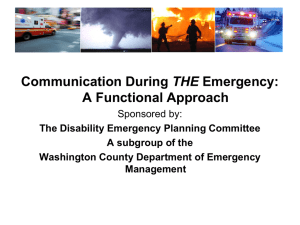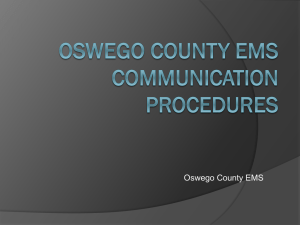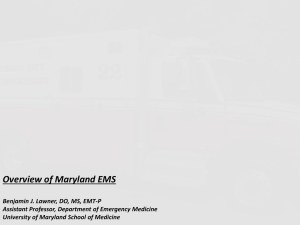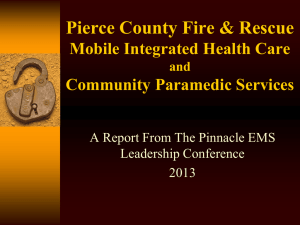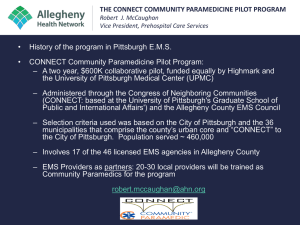Best Practices in EMS 2010
advertisement
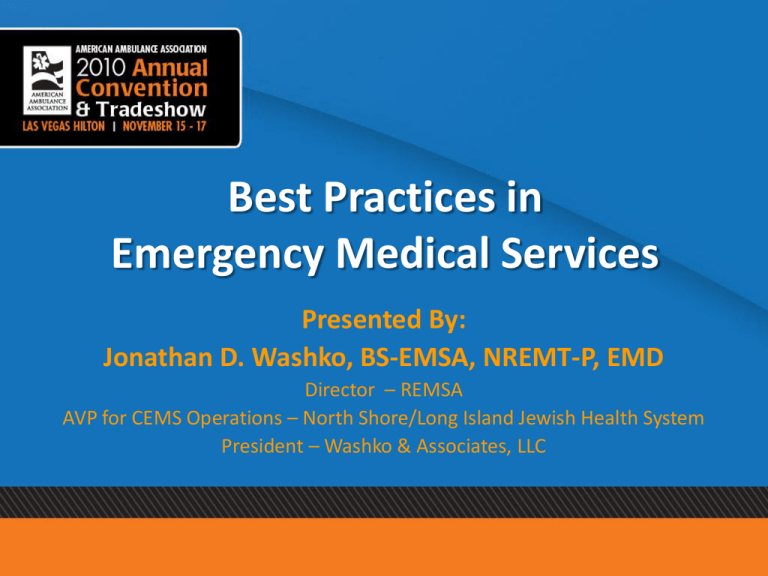
Best Practices in Emergency Medical Services Presented By: Jonathan D. Washko, BS-EMSA, NREMT-P, EMD Director – REMSA AVP for CEMS Operations – North Shore/Long Island Jewish Health System President – Washko & Associates, LLC Best Practices in EMS Overview • • • • • • • What is a best practice Why EMS needs best practices The theory of EMS Darwinism The economy and best practices Best practices dissected & discussed Not so best practices Wrap up / Q&A REMSA’s Military Support • REMSA was a 2008 Recipient of the Freedom Award • Recently had 5 Medics on active duty in Afghanistan • Supported our troops in various ways – Keep REMSA Salary whole while on Active Duty – Provide 100% Benefits coverage while on Active Duty Including Family – Send along laptops, software & other needed items – Send monthly care packages to our employees What is a “Best Practice” Wikipedia defines it as… A Best Practice is the belief that there is a technique, method, process, activity, incentive or reward that is more effective at delivering a particular outcome than any other technique, method, process, etc. The idea is that with proper processes, checks, and testing, a desired outcome can be delivered with fewer problems and unforeseen complications. Best practices can also be defined as the most efficient (least amount of effort) and effective (best results) way of accomplishing a task, based on repeatable procedures that have proven themselves over time for large numbers of people. Why EMS Needs “Best Practices” • The Theory of EMS Darwinism • Service delivery model variations / inconsistencies • Lack of commonly accepted operational standards (like NFPA for Fire Service) • Mix of public / private / government ownership • Mix of for profit / non-profit models • Lack of standardized advanced managerial education platform • Industry has attempted to bridge educational gap with limited success • Success lies in sharing clinical & billing best practices but not operational ones Why Best Practices? “As EMS providers, we invite the public to literally trust us with their lives. We advise the public that, during a medical emergency, they should rely upon our organization, and not any other. We even suggest that it is safer to count on us, than the resources of one’s own family and friends. We had better be right. Regardless of actual performance, EMS organizations do not differ significantly in their claimed goals and values. Public and private, nearly all claim dedication to patient care. Efficient or not, most claim an intent to give the community its money’s worth. And whether the money comes from user fees or local tax sources, the claim is the same—the best patient care for the dollars available. It’s almost never true. Our moral obligation to pursue clinical and response time improvement is widely accepted. But our related obligation to pursue economic efficiency is poorly understood. Many believe these are separate issues. They are not. Economic efficiency is nothing more than the ability to convert dollars into service. If we could do better with the dollars we have available, but we don’t, the responsibility must be ours. In EMS, that responsibility is enormous—it is impossible to waste dollars without also wasting lives.” Jack L. Stout The Theory of EMS Darwinism • Darwinism / Evolutionary Theory – Isolated environments produce similar species that evolve in different ways from each other – Evolutionary adaptation to the environment occurs to ensure survival of the species – EMS has “evolved” under these principles The Theory of EMS Darwinism • EMS agencies are isolated from each other due to proprietary barriers created by varying system designs, ownership models and funding sources • Gives credence to the phrase “If you’ve seen one EMS system, you’ve seen one EMS system” • However, they are still of the same species… • Common operational denominators exist for every EMS system which provide the foundation for “Best Practices” • Acceptance of these “Best Practices” depends on your system design, necessity for change, culture and other factors The Theory of EMS Darwinism Fire Based Private For Profit EMS Private Nonprofit Hospital Based 3rd Service My industry “Best Practice” experience has been… Necessity may be the mother invention however… …it also drives acceptance of the previously unacceptable Current / Future Economic and Demographic Conditions • If there ever has been a time where necessity will drive innovation, acceptance of the unacceptable and the merging of separately evolved species into one, it is now! • Shrinking public funding mechanisms, uncertain healthcare dollars and rising unemployment in the face of a large aging boomer generation will force industry innovation and change • Funding / service level / employment compensation tradeoff’s or service delivery model design changes…you decide (as may the current presidential administration) Best Practices in EMS - Disclaimer • Best practices mentioned in this presentation are based on my personal exposure / experience with numerous EMS systems across the US, Canada and other European nations • I know many other best practices beyond those mentioned in the presentation exist, I have just not had the privilege of seeing or learning about all of them as of yet • If you know of a best practice and would like to share it please feel free to do so anytime during the presentation Best Practices in EMS • • • • • • • • • • • • Deployment Science Operations Supply / Logistics Fleet maintenance Human resources Training / education Quality Improvement Billing / Finance Communications Technology Trends EMS System Designs EMS Response to Pandemic Deployment Science Best Practices in EMS Best Practices in EMS Deployment Science • Setting service reliability standards and then meeting them for emergency and non-emergency service – e.g. Life threatening emergencies responded to within 8 minutes 90% of the time • Measure response times ACCURATELY (no smoke and mirrors) – Fractile measurement approach not average – Call received in 9-1-1 center to on scene Best Practices in EMS Deployment Science • Using deployment methodologies that match supply and demand both temporally and geospatially – Production Model EMS / SSM / Peak Load Staffing – Station/post move-ups based on demand not geography • Realize that deployment methodology and response time service reliability are just as important as the medicine we provide – Life-saving treatment is worthless if it is not provided in time – Deployment methodology drives labor costs up or down which has a direct effect on the quality of medicine we can afford to provide given the current reimbursement mechanisms Best Practices in EMS Deployment Science • Technological edge – Live decision support tools for making resource deployment decisions in real-time • MARVLIS • SIREN • DECCAN • CAD vendor specific features – Balanced matching of service demand needs with human needs • Zoll Resource Planner – In-vehicle smart routing systems that use live or historical road network data to adjust routes and candidate rankings Ambulance Operations Best Practices in EMS Best Practices in EMS - Operations • Vehicle design conducive to long-term, in ambulance shifts – DVD / entertainment systems – Larger front cabs to allow for reclining in front of unit • Field supervisors capable of on-site / on demand lost unit hour mitigation – Solve a variety of issues that would take an ambulance out of service or cause service inefficiency – Resupply of medical supplies, fixing of vehicle problems, availability of backup equipment, bariatric stretcher delivery Best Practices in EMS - Operations • Managerial Front – Recognition of “generational differences” and how to overcome them – Moving away from performance based compensation programs – Recognition that physical separation of employees from management leads to unions and/or poor employee / employer communications – Recognition that the best clinicians don’t necessarily make the best organizational leaders Best Practices in EMS - Operations • Managerial Front Continued… – Recognition that our leaders and managers need training in leading and managing people not just systems and processes – You don’t have had to grow up in it to lead it and manage it (especially if these things come naturally) – Recognize the importance of balancing internal promotional opportunities and the need for outside talent to stay fresh Best Practices in EMS - Operations • Recognition that 24 hour shifts in busy urban EMS systems are not conducive for safety or quality patient care – Appropriate for suburban / rural areas with high difficulty of coverage indexes or proper economics • Recognition that EMS is a 24x7 business and should be managed as such – Lessons from other public safety disciplines • FD / PD management systems • Integration of ICS into daily routines to improve EMS familiarity – FD is using this against many private EMS services Best Practices in EMS - Operations • Technological Edge – Online scheduling systems • Allow for online management of schedule, shift trades, PTO, OT pickup, etc. • Integration into CAD or other decision support tools • Zoll Crew Scheduler, eCore, ADP, Telestaff, eSchedule, Others – Employee communications • Twitter / Facebook VERY effective tool if managed and administrated properly (push based messaging vs pull) • Many ePCR / eScheduling / time and attendance systems allow for broadcast and individual messaging • Email systems may or may not be effective • Reader boards with “Flash & Pizzazz” • Office Live / SharePoint Server Best Practices in EMS - Operations • Affordable and simple situational awareness & interoperability systems – CAD companies solutions often lack or lag – New industry popping up to solve these issues • • • • FleetEyes GPSLogic BCS FirstWatch Best Practices in EMS - Operations • Recognition of the fact that our patients care about: – – – – – Timeliness Customer Service Look & Feel (Professionalism) Ambulance (Ride, Cleanliness, Organization) Quality Patient Care (Assumed) • Measurement & benchmarking of these quality markers (if you can’t measure it you can’t manage it) – MHR’s EMS Survey Team (Operational outcomes QI) – Traditional Clinical QI Best Practices in EMS - Operations • Demand Management Systems – Community / advanced paramedic programs • Help to mitigate system abusers that fall through the social safety net • Provide recidivism protection for certain patient demographics for hospital readmissions (CHF example) • Specialized services (Echo, SCT, SWAT, Haz-Mat) – 911 call centers match right patient to right resource type at the right time and right cost • Medical necessity screening system for 9-1-1 Supply & Logistics Best Practices in EMS Best Practices in EMS - Supply & Logistics • Centralized deployment facilities / hubs • EMS providers not responsible for checking supply levels, washing vehicles or maintaining vehicles • Fleet-wide standardization of ambulance design • Assembly line style standardized resupply systems “speed loaders” – – – – – Streamlined restocking processes Improves supply reliability Improves resupply efficiency Eliminates waste “Lean Manufacturing” GFGGS Service Points Workflow SERVICE POINTS WORKFLOW “Once Around The Ambulance” Best Practices in EMS - Supply & Logistics • Technological Edge – Just in time ordering systems that minimize the need for warehousing of vast amounts of supplies – Online inventory, asset tracking and ordering systems provided by vendors • AmbuTrak • IOS – Bar coding / RF ID systems – Electronic check-in/out equipment accountability systems Fleet Practices Best Practices in EMS Best Practices in EMS - Fleet Practices • Preventative maintenance (PM) programs that mimic the airline industry • “Green” initiatives including solar charging systems, bio-fuels, lighter/smaller vehicles, etc. (carbon fiber boxes coming soon) • Bridging the Ford 6.0 liter issues – Refurbishing 7.3 liter chassis – Class action law suit – Gas / diesel Best Practices in EMS - Fleet Practices • Technological Edge – Onboard “black box” driving computers that provide Gforce feedback and record/transmit data wirelessly • Road Safety – Cameras that capture significant events • DriveCam, EnVision Cam – Wireless in-vehicle routers that provide internet access via the cellular data networks • InMotion / Sierra Wireless – Convergence technologies (combine all of the above - plus) • GPSLogic – Fleet maintenance tracking software that allows for part failure analysis that is integrated into the PM system Best Practices in EMS – Fleet Practices • Safety – Vehicle safety initiatives • Concept Vehicles – AMR, LifeEMS, SJC Side Load – Stretcher improvements • Improved patient loading systems – Bariatric management systems – NFPA 1917 vs KKK ??? Human Resources Best Practices in EMS Best Practices in EMS - HR Management • Proactive headcount management practices – Measurement of certain KPIs • FTE weighting (FT, PT, PRN) • PTO usage • Turnover management (anticipate loss) • Streamlined policies & procedures directly linked with accreditation standards (C.A.A.S. / C.A.M.T.S. / A.C.E.) • Academy style orientation programs for new hire employees • Internal EMS education for EMT & Paramedic certifications with working scholarships – Paid PD/FD style educational academy • Policies on social networking impacts on the workplace Best Practices in EMS - HR Management • Technological Edge – Online employee tools for benefit management and administration – Online policies and procedures access – Paperless employee files with secure access available to management 24x7 – Streamlined business systems that talk to each other • HR Systems <-> eScheduling <-> Pay Roll <-> CAD <-> ePCR <-> eCertification Systems Best Practices in EMS – HR Management • Candidate selection – Personality and intelligence screens that match job functions • AVESTA • Criticall • ADP Training / Education Best Practices in EMS Best Practices in EMS - Training / Education • Online systems for off-site training & Certification Tracking – Web based meetings / presentation systems • WebEx, GoToMeeting, NEFSIS, etc. – On demand content provision (proprietary or purchased) – Online testing / certification systems – Industry specific applications (Centrelearn, Ninth Brain) • Simulation Labs – Sophisticated simulators / manikins – Lab designed just for simulation training scenarios • Real-time on-duty scenario training / testing Best Practices in EMS - Training / Education • Using training and education programs to supplement your system’s revenue and offset training overhead costs – – – – AHA training Private industry training Ancillary healthcare services training Government / military • Portable training programs with portable simulation labs – Increase training reach to remote markets – Open up new opportunities – Rural services • Accreditation of training programs and centers • Affiliations with higher educational institutions • In-house Paramedic training programs Quality Improvement Best Practices in EMS Best Practices In EMS - Quality Improvement • Using ePCR systems to improve QI efficiency, effectiveness and portability • Using advanced automated QI systems that enable 100% auditing of charts against clinical documentation and protocol standards • Adopting QI workflows that improve employee communication, feedback loops and remediation for improved behavior modification Best Practices in EMS – Quality Improvement • Recognition that CLINICAL QI and BILLING QI go hand in hand and should be closely tied – Break barriers between Billing and Ops/QI • Peer review programs more viable with ePCR • Using data to drive decision making on clinical upgrades, downgrades and changes • Using clinical data in assessing operational issues Billing / Finance Best Practices in EMS Best Practices in EMS - Billing / Finance • Paperless ePCR systems making A/R a much more efficient and effective process • Granular financial statements that group each service line and operation individually for improved decision making abilities • A/R tracking by customer with monthly financial trigger processes to identify payer/patient problems • Invisible Bracelet technology emerging that supplements the old Medical ID Bracelet with demographic information (Meds, Allergies, Contacts, Insurance information) Best Practices in EMS - Billing / Finance • Lean business processes that measure productivity and performance • Internal Federal Compliance auditing by an independent agency / auditor • Quality based reimbursement initiatives at the Federal level • Online payment and account management options • Electronic insurance clearing houses will limit the need for skip-tracing efforts (but at a cost) Communications Best Practices in EMS Best Practices in EMS - Communications • “Situational awareness” / “decision support” • EMD System – Call classification for resource triage (priority based dispatching processes) – Pre-arrival instructions – Demand management systems – Pandemic / CBRN screening system • Live data surveillance systems – – – – Syndromic / bio-terrorism Operational Sentinel event Geospatial Best Practices in EMS - Communications • CAD systems – AVL / GPS integrated – Dynamic road network speed algorithms for routing and candidate ranking – Real-time demand surveillance – Real-time deployment decision support systems – Live off-site redundancy & backup systems • Phone / Radio systems – Phase II wireless compliance – IP based communications systems (NG911) – Digital IP based radio systems Best Practices in EMS - Communications • Non-emergency trip optimization decision support systems are coming soon – System that analyzes the mathematics associated with the performing and scheduling NET trips • Requested / Promised Pickup Time • Call segment weights (on-scene time, drop-off time) • Route travel times (travel – transport) – Provides predictive availability of system resources for improved throughput (more with less) and accurate scheduling of calls for patients Technology Trends Best Practices in EMS Best Practices in EMS – Technology Trends • Traditional EMS centric software business models are set to fail us as an industry (and already have) – Once market penetration hits, maintenance fees can’t sustain the infrastructure therefore these companies are forced to diversify to survive and customer service / enhancement cycles don’t meet our expectations or needs – Compare and contrast any SAAS based business model against this traditional one • • • • ePCR / eScheduling / eHR / ePayroll / eBilling vs ANY CAD System Emergence of “CAD can’t so we will” companies Ability to meet our needs (new functions and features) Customer service Best Practices in EMS – Technology Trends • Software as a service (SAAS) will soon dominate most (if not all) of our technologies – Cloud based computing & data storage – Billing / CAD / Payroll systems are HERE or coming! – Highly cost effective due to economies of scale these systems bring without the need for infrastructure or on-site support – High reliability due to “groups” ability to buy into technology they could never afford on their own Best Practices in EMS – Technology Trends • EMS Industry has been fickle in accepting SAAS – Customer ROI, cost effectiveness or “Flash and Pizzazz” appears to drive adaptation – Senior leadership whom don’t trust the technology or think they have to have it local to maintain control – Reliability / Redundancy issues (internet) – Private industry quicker to adopt then government (jobs at stake) – K.I.S.S. principle typically used may keep some away • E.g. The use of OTC GPS units EMS System Design Best Practices in EMS Best Practices in EMS - EMS System Designs • System designs must comprehend EMS economics to survive – Not effected by typical elasticity of supply & demand • Population size, age, socio-economics & other demographics – Pricing / quantity does not drive increases or decreases in overall service area demands (volume) • May shift it from one provider to another however – Free market competition drives up costs / prices down / drives down quality / forces stupid loss leader ideologies in order to gain market share – System fragmentation decreases economies of scale, significantly increases costs of operations and typically provides for poor patient care (response times) Best Practices in EMS - EMS System Designs • No EMS system design is “perfect” • “Successful” ones include the following features: – Limited or zero local tax subsidy – Service accountability through performance guarantees and standards – Ability to replace the provider for performance failures Best Practices in EMS - EMS System Designs • “Successful” ones include the following features: – Closed market with sole source provider performing emergency and non-emergency services (most economically efficient model) – Rates and performance controlled through publically accountable external entities (not internal) • Ham & Eggs breakfast analogy – (Chicken has a stake but the pig is committed) – Balance patient care, employee wellbeing and financial responsibility Best Practices in EMS - EMS System Designs • Recognition that the deployment model used within an EMS system has a direct correlation on system costs and patient care effectiveness and outcomes – Demand driven systems provide considerably better service reliability to a much larger patient population – Fixed geographic based systems provide good service to the first patient, but not necessarily the second, third and so on (work well for areas with low second call probability) – History, economics, unions and politics are typical determiners of EMS system design type until the EMS system kills the wrong person or costs too much money Best Practices in EMS - EMS System Designs • Recognition that we may not make as large of an impact as we once thought – So busy proving that we could no one ever stopped to ask the questions if we should (until recently) – ALS may not be as important as once thought – True clinically significant response times – Understanding Risk/Cost/Benefit (Read Freakonomics) • Low risk/ROI probabilities coupled with “scary” public perception situations drives irrational responses / behaviors – Pediatric Drowning vs. Gun Ownership & Child Shootings • Foundation that IAFF/IAFC is using to sway public opinion and politicians Pandemic Response Best Practices in EMS Best Practices in EMS - Pandemic Response • EARLY screening / surveillance during the 9-1-1 call – NAED SRI Screening / Card 36 Pandemic Flu • Based on findings, first responders (FD/PD) and EMS personnel “suit up” PRIOR to entry / patient contact – Protect your assets (lessons learned from SARS) – Reverse isolation of patient • Protocols / processes for system overload, denial of service or altered response configurations – 6-1-1 Information lines / 9-1-1 call center demand shifting – Public & public safety information systems imperative Best Practices in EMS - Pandemic Response • Consider supply needs PRIOR to the incident – Isolation supply caches – Cleaning / decontamination supply caches – Enough for everyone (FD/PD/EMS/Family)? • ICS system / Command & Control may rest with the Health Department – Poor experience with ICS / EMS / Public Safety – Public health focus on the epidemiology / medicine / treatments – Communication channels may be limited or nonexistent Best Practices in EMS - Pandemic Response • Consider personnel needs (different then disaster) – Shelter in place requirements / isolation impact – Logistical needs of your personnel • Consider other infrastructure support needs – All items needed to provide service – AMFYOYO – remember this will be large scale, wide spread and concurrent events nation / world wide • Communicate / Communicate / Communicate – – – – The public Employees & their families Public safety agencies Health Department / CDC / WHO Worst Practices in EMS Worst Practices in EMS • Lack of Standardization (we need an NFPA for EMS!) – Standardization of operational, clinical & financial measurements – Standardization of technology • EKG Data (move away from proprietary standards) – Standardization of clinical data (on our way) • NEMSIS -> HL7 • Limited common industry voice in Washington on issues other then reimbursement Worst Practices in EMS • Funding/reimbursement INSANITY • Over regulation that drives up system costs and complexity with VERY small return on investment (lives saved) • Allowing the Fire Service to “scare” the public with emotionally based tactics to sway politically based outcomes (Freakonomics) – Private EMS is under attack!!! (in case you haven’t figured that out yet) Worst Practices in EMS • Lack of a common union representing the industry…Luke….if you only knew the power of the dark side of the force…. – Good for employers…bad for industry…also based on who is in political power – IAFF • Lack of substantial lobbying dollars – The fact that I am having to say this is a worst practice for our political process A Final Thought… www.jackstout.com • A new web resource now available on line • Sponsored by / provided by – – – – Todd Stout of FirstWatch Jonathan Washko of Washko & Associates, LLC CAEMS (Coalition of Advanced Emergency Medical Systems) David Williams (Help to collect the articles for this collection) • All of Jack’s writings now available for download – JEMS Interface Articles – 4th Party Manuals – Other writings • Looking for help to transcribe his works to make them searchable on the internet Best Practices in EMS Questions & Answers Share Your Best Practices… Copies of this presentation will be available at: www.washkoassoc.com
